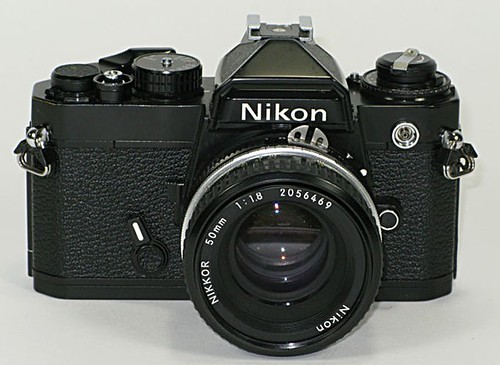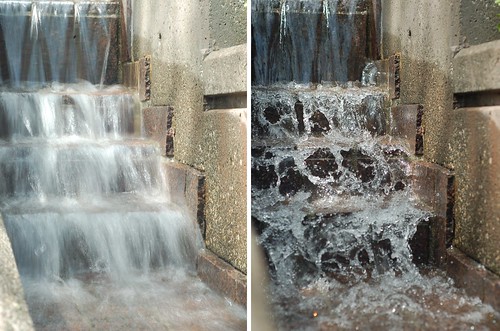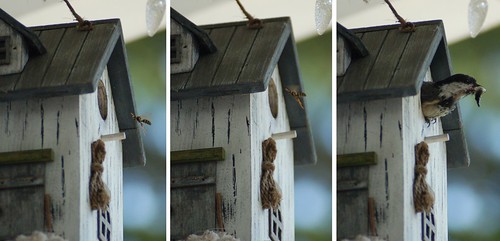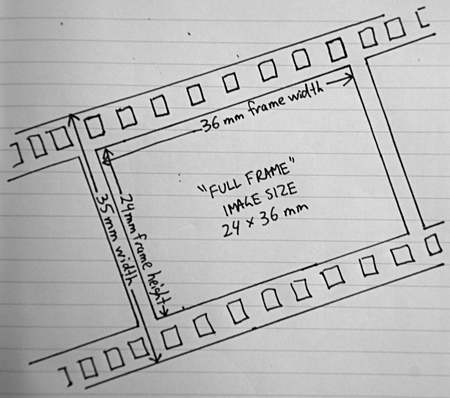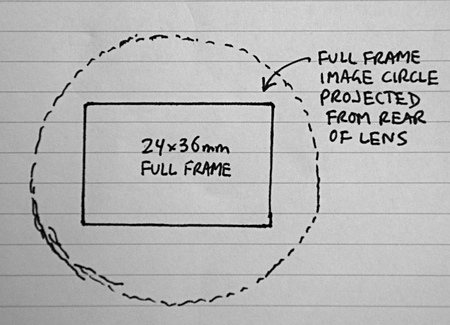Penmachine
21 April 2010
Back to 1978
A couple of years ago, I bought an old Nikon F4 film camera (introduced in 1988), and I've enjoyed taking pictures with it, especially in black and white. It's a pretty big beast, though, and over time I've been thinking about the first camera I bought for myself in the early '80s, a manual-focus Nikon FG. Then I spotted a surprisingly cheap deal on eBay, and this week it arrived:
It's a Nikon FE, a slightly older (introduced in 1978) and slightly higher-end model than my FG, and it came with a manual-focus 50 mm Nikkor lens. For many years, the electromechanical FE, its companion mechanical FM, and their successors the FE2 and FM2 were often the backup camera bodies of choice for professional photographers—less expensive than the top-of-the-line F2, F3, or F4, but still rugged and simple to use.
Like my F4, this thing feels like a brick, because unlike the digital cameras most people buy today, the FE is almost all metal, including the lens housing. It's also surprisingly small, since it lacks the rubberized covering and big handgrips that digital SLRs like my D90 have. (Since film is out of fashion, the FE also cost me a tiny fraction of the price of the D90.)
Besides my general Gear Acquisition Syndrome and the dirt-cheap price, another reason I bought the FE is that my younger daughter L has been wanting to learn a bit more about photography, and the principles are much easier to demonstrate on an old film camera. With a fixed (non-zoom) lens on it, there are really only three things to adjust: aperture, shutter speed, and focus. DSLRs let you change ISO (sensitivity) and white balance too—among many, many other features—but with the FE those are determined by the film you choose.
I've loaded the FE with some 400-speed black-and-white film, and we'll see how the first photos turn out, and how the photographic experience compares to the F4 and D90. A nice feature of film cameras (despite the inconveniences) is that, whenever you buy new film, you're effectively putting a new sensor inside, so they don't really become obsolete the way digital cameras do.
Labels: cameraworks, family, geekery, nikon, photography
10 June 2009
Camera Works: pictures that tell a story
Here are three photos I recently uploaded to my Flickr account, each with an accompanying story but otherwise unrelated. The first one shows the practical applications of knowing how your camera works, while the others are just for fun. Click each photo to zoom it:
Two waterfalls:
Actually, it's two photos of the same waterfall, taken a few seconds apart using my Nikon D50 digital SLR and a 50 mm lens, showing how you can change an image by controlling the aperture and shutter speed.
- For blurry water: I snapped the left photo at f/22 (a small aperture) for 1/8 of a second, blurring the water with a long shutter speed. I didn't have a tripod, so I rested the camera against the edge of the fountain for stability.
- For frozen splashes: The right photo was at f/3.5 (a wider aperture) for 1/800 of a second, freezing the motion of the water with a short shutter speed. The camera was in the same place, but because of the fast shutter I didn't need to be so careful about not moving it.
Depth of field differences: It's not that easy to see, but the right photo with the fast shutter speed also has shallower depth of focus because of the larger aperture. That's particularly noticeable when you compare the concrete edge at the lower left corners of the two frames.
Where is this? The fountain is on Birch Street between Broadway and 8th Avenue in Vancouver, if you want to visit it yourself. It's pretty cool: two streams flow down on either side of a set of steps. This is the north side.
Drama at the birdhouse:
This isn't quite as dramatic as it looks at first glance. While the photos are in the correct order, the chickadee didn't eat the wasp—it just scared the insect away, with food already in its mouth.
We have chickadees raise babies in this birdhouse on our back porch every year. But this year this one bird (the mom?) looks especially beat-up and scraggly, and has looked that way for weeks. Is is just old, or did something nasty happen to it? Seems to be feeding the kids just fine, though.
I used a long focal length, higher ISO (sensitivity), and fast shutter speed (plus some patience) to get this series.
Exploded Coke Zero:
I guess our downstairs fridge was set a bit too cold. Good thing sugar acts as an antifreeze, so that it was the sugar-free (and non-sticky) Coke Zero that froze and exploded first. Still a bit of mess to clean up inside the fridge, though.
This photo required a flash, both because the room was a bit dim and because I wanted to highlight the glittery goodness of the unintentional Coke Zero slush.
Labels: animals, cameraworks, food, photography
18 March 2009
Camera Works: image stabilization (VR, IS, and SR)
 I just acquired my first stabilized camera lens, and I'm impressed so far, especially because it didn't cost me anything. Here's the story.
I just acquired my first stabilized camera lens, and I'm impressed so far, especially because it didn't cost me anything. Here's the story.
Sent for service
Last year I had my relatively new Nikon 18-135 mm zoom lens (designed for the D80 SLR, but bought for my D50) repaired under warranty, after the autofocus became unreliable and the lens housing felt loose. Unfortunately, Nikon's low-end lenses don't seem to stand up especially well to the usual wear and tear of enthusiastic use, because recently I had the same problem again with the same lens: unreliable autofocus and loose feel with the lens mounted on my camera, less than a year after the repair.
(By the way, I have a couple of much older but higher-end Nikon lenses that continue to work flawlessly despite their advanced age and considerable use. The problem is either with the company's more cheaply made lenses or with the particular one I owned.)
Anyway, the lens is covered by Nikon's excellent five-year warranty. So once I sent the zoom in for its second repair, Nikon had a look at it and decided to send me a replacement instead: the newer 18-105 mm VR zoom, introduced with the new D90 SLR a few months ago. While it doesn't zoom in quite as far, the newer lens includes Nikon's vibration reduction system—that's what the VR stands for.
What is vibration reduction?
What Nikon calls vibration reduction (VR), other camera makers call image stabilization (IS) or shake reduction (SR).They're all the same thing. Vibration reduction is a new technology, emerging in commercially available optical devices only in the last ten years. It can be built into the lens (as Nikon and Canon do) or the camera body (as Sony and Pentax do), but both work basically the same way: motion sensors detect the tiny shaky movements you make when hand-holding a camera and compensate for them by moving lens elements (Nikon, Canon) or the camera sensor (Sony, Pentax) with tiny motors.
At slow shutter speeds or long focal lengths, that reduces shake-induced blur in your photos. The technology doesn't make moving subjects (people, vehicles, animals) less blurry, because it can only compensate for things that make the camera vibrate.
The results
But within its limitations, VR works quite well. Take a look:
When using VR, looking through the viewfinder can be a bit strange, because the image you see is steadier than your hands. It's even more noticeable on my dad's image-stabilized binoculars, which magnify the image quite a bit more than my zoom lens, and stabilize both eyepieces. You can feel your hands shaking quite a bit as you look through them, but the image moves in a much more "damped" manner.
The result is great, because both in a camera and through binoculars, you can see more clearly when VR is on. And when you take photos of stationary subjects, you can shoot with shutter speeds one or two stops slower (i.e. taking in only 25% as much light, maybe even less) and still get decently sharp pictures.
It's not the same as having a lens with a wider maximum aperture, or a camera with better low-light sensitivity (ISO), but it's another tool to help make better images.
Labels: cameraworks, geekery, nikon, photography, repairs
13 December 2008
Camera Works: why "digital" lenses are cheaper
If you buy a non–high-end digital SLR (DSLR) camera, it will probably come with what's known as a "digital" lens. There's no such thing, really: lenses for any kind of camera are analog devices that bend light with glass—or maybe plastic—just as they have been since lenses were invented centuries ago.
What "digital" means in this case is that the lens is designed to be used with the most common type of digital SLR camera, those with crop-frame sensors. Crop sensors are smaller than the traditional 35 mm film dimensions used in more expensive full-frame sensors. So lenses designed for them project smaller circles of light. If you put them on a full-frame camera (that is, if they will even mount), this is what you get:

My AF Nikkor 18-135 mm f/3.5-5.6G digital ("DX") lens has a big black vignette circle around the image when zoomed out to 18 mm and mounted to my full-frame Nikon F4 film SLR. Click the image to see a representation of where a crop-frame sensor would fit in the image circle.
Lenses for traditional non-digital and full-frame SLR cameras also work just great on crop-frame models, but the extra money you pay for their wider image circles goes to waste, because the image around the edges doesn't get captured on the sensor. But I own one crop-frame lens for my crop-frame camera, and several full-frame lenses. Why?
The benefits of buying crop-frame digital lenses are that they're smaller, lighter, and cheaper—and they may offer focal lengths unavailable in their bigger brethren. But the benefits of buying full-frame lenses, conversely, are that they will still work fully if you later upgrade to, or want to borrow or rent, a full-frame camera body; and that they are generally better built because they are aimed at the professional photographers who tend to buy full-frame.
« Previous: intermediate f-stops
Labels: barcamp, cameraworks, geekery, photography
22 November 2008
Camera Works: intermediate f-stop values
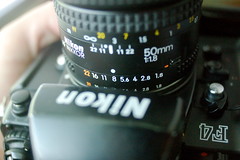 The aperture and f-stops article in my ongoing Camera Works series has been popular, but it has also raised some questions. Here's one from Mike S.:
The aperture and f-stops article in my ongoing Camera Works series has been popular, but it has also raised some questions. Here's one from Mike S.:
How much ISO would I gain?
I just read your blog on f-stops. Very informative and I learned things I had given up on. I do have a question. Keep in mind I'm not mathematically inclined. I am trying to figure out how much ISO I would gain, meaning lower ISO, if I shot at a 1.8 setting versus a 2.8? I currently only own 2.8 lenses and find myself shooting indoor sports at ISO 3200 at about a 320th of a second. My goal is to get the ISO to 1600 or lower while keeping the 320 [shutter speed] as a minimum. How would I figure this out? I wasn’t sure if 2.8 was double 1.8.
My answer is that lens at f/1.8 does not let in double the light of a lens at f/2.8: it lets in more than that. About 2.4 times as much light, in fact. We'll see why below.
As I described in that original article in August, the sequence of full stops runs in multiples of 1.4 (actually the square root of 2, which is 1.41421356..., but close enough), so if you start at f/1, you have:
1, 1.4, 2, 2.8, 4, 5.6, 8, 11, 16, 22, 32, 45, 64
(You won't see f/45 or f/64 on normal SLR or point-and-shoot lenses, but they're not uncommon on large-format cameras.)
Each of those values lets in half the light of the stop to the left, and twice the light of the stop to the right. So in Mike's case, using a lens that can open to f/2 instead of f/2.8 will let him use either twice the shutter speed or half the ISO (light sensitivity) setting. But what about f-stops that don't fit that sequence, like f/1.8 or f/3.3?
Figuring out intermediate f-stops
This takes simple real-world f-stop math, but it's just multiplying and dividing, so it's not hard. The old area-of-a-circle equation (πr2) gives you the answers:
- If you're at f/2.8, the diameter of your aperture is 1/2.8 the focal length of the lens (or about 0.357 the focal length).
- If you're at f/1.8, the aperture is bigger, 1/1.8 (or about 0.556 the focal length).
- The ratio of the two aperture diameters, 0.556 to 0.357, is about 1.56 (just divide 0.556 by 0.357), so f/1.8 is about 1.56 times wider than f/2.8. (You could actually do this more simply: 2.8 divided by 1.8 gives you the same number, about 1.56.)
- From that area-of-a-circle equation, since the area (and the light let through) changes by the square of the diameter (or radius, it doesn't matter in this case) of the aperture, simply square that ratio value (1.562) to get about 2.4.
- So f/1.8 lets in about 2.4 times more light as f/2.8, and f/2.8 lets in about 2.4 times less light than f/1.8.
What does that mean?
Here's how you can use that knowledge:
- If you stay at ISO 3200 and it works at 1/320 of a second at f/2.8, you can shoot 2.4 times faster if you go to f/1.8, which would be (320 x 2.4) or 1/768 sec (or 1/750, rounded to the nearest realistic camera shutter speed).
—or— - If you're adjusting ISO and keep the shutter speed fixed, you can shoot at 3200 divided by 2.4, or ISO 1333 (more like 1250 in real-world terms) if you click from f/2.8 to f/1.8.
This reveals something. In the old days of film, photographers used to think in terms of two variables: shutter speed and aperture. That's because the third one, sensitivity or ISO (also known previously as ASA), was fixed for each roll of film. You had an ISO 400 roll, or an ISO 64 roll, or a high-speed ISO 1000 roll, but that was it until you changed the film.
In the digital age, we now have that third variable, because we can adjust the ISO as much as we want, or even have the camera adjust it automatically for changing lighting conditions, so that each picture can use its own ISO setting, as well as its own aperture and shutter speed.
The simple version
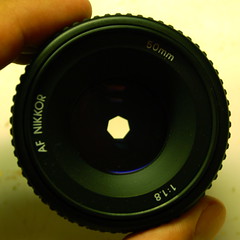 All right, so here is the simplified version of what to do when you want to know how two different f-stops affect ISO and shutter speed:
All right, so here is the simplified version of what to do when you want to know how two different f-stops affect ISO and shutter speed:
Divide the bigger f-stop number by the smaller one (2.8 divided by 1.8, for example) to get the ratio of their diameters. Then square the result to find out the ratio of light let through. Next, multiply or divide your shutter speed or ISO by that value to figure out how you need to adjust it.
Or let your camera's meter figure it out!
The nice part is that while you have to square the aperture ratios to determine how much light is let through, shutter speed and ISO simply multiply or divide by 2: 1/500 sec lets in half the light of 1/250, and ISO 3200 captures twice the light of ISO 1600, so the rest of the math is straightforward
Another example
- I'm at f/3.3 at 1/2000th of a second at ISO 200 and I stop down to f/16 because I want more depth of field.
- 16 divided by 3.3 is about 4.85.
- 4.85 squared is about 23.5, so F/16 brings in 23.5 times less light than f/3.3.
- So I need a shutter speed 23.5 times slower to let in the same amount of light. 2000 divided by 23.5 is about 85.1, so I need 1/85 of a second (or 1/90, rounding off for most cameras) to get the same exposure.
- Or I can adjust the ISO: 200 times 23.5 is ISO 4700, and I can still shoot at 1/2000. I'll need a pretty new, high-end DSLR to get that high an ISO value, but it is possible.
- You can also combine things. If I decide to shoot at 1/1000 of a second, I can halve the ISO to 2350 at f/16, more in the range of regular cameras these days. Many won't let you set the ISO to incremental values like that manually, but they will do it in Auto ISO modes that keep shutter speed and aperture fixed and adjust ISO to match the exposure, as I mentioned above.
When you spin the aperture dial on your camera and see intermediate values—or if you have a lens with a physical aperture ring with clicks in between the full-stop values and a maximum aperture not on that scale, like f/3.5, f/4.5, or f/6.3—now you know what those values represent.
One stop can be expensive
People taking sports photos typically use a zoom or telephoto lens with a focal length of 200 mm or so. You can buy a very nice 70-200 mm zoom that opens to f/2.8 from Canon, Nikon, and others for between $700 and $1700 USD. Not cheap, but worth it if that's what you need to do.
But if you want a 200 mm lens that opens one stop wider, to f/2? Nikon and Canon make them. They're huge, and will set you back something like $5000. Back in the '80s Nikon even made a 300 mm f/2 lens. List price? $29,000.
Modern digital cameras with good performance at high ISO sensitivity, and lenses with image stabilization, now make it possible to get similar results (one stop faster) for much, much less money.
« Previous: shutters and flashes
Labels: barcamp, cameraworks, geekery, photography
15 September 2008
Camera Works: shutters, flashes, and sync speed
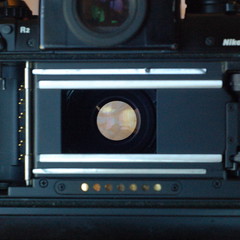 The shutter of a camera seems pretty simple. For years, I thought of it the way it's described: as a shutter curtain. You know, as a sheet (metal, cloth, whatever) near the back of the camera that behaves like this:
The shutter of a camera seems pretty simple. For years, I thought of it the way it's described: as a shutter curtain. You know, as a sheet (metal, cloth, whatever) near the back of the camera that behaves like this:
- Most of the time, it's closed, to keep light from hitting the film or digital sensor.
- Press the camera button, and the curtain swishes open (really really fast), exposing the film or sensor to light from the camera lens. Click!
- Then, it stays open for the time you set (whether 4 seconds of 1/4000th of a second).
- Finally, it swishes closed again (really really fast), returning the back of the camera to darkness. Click!
That's straightforward, especially once you have a grip on focal lengths and f-stops. But it's also wrong. Camera shutters are a bit more complicated than that, and understanding that complexity can help you make better photographs.
How does a shutter work?
If you have a point-and-shoot digital camera, or a camera in your mobile phone, you'll never see its shutter. That's partly because you can't get inside the camera to take a peek, but also partly because many small digital cameras don't even have a shutter. (I'll explain why below.)
But let's ignore that for now. In the long, long history of film photography, cameras had to have some sort of shutter, since that was the only way to achieve two important goals:
- Keeping light from hitting the film when you didn't want it to.
- Making sure that light did hit the film when you wanted it to, but only then.
Camera manufacturers spent over a century figuring out how to make shutters faster and more accurate. There have been many designs in that time. Some tried leaf shutters that are part of the lens, with blades that open like the lens's aperture. (Many medium-format cameras use in-lens leaf shutters.) But the type most photographers are familiar with is the focal plane shutter, which sits right in front of the film and, in its simplest form, behaves something like the curtain I described above.
Before the 1980s, many SLR shutters were fully mechanical, relying on springs and levers for actuation and timing. In recent years, only specialist and boutique film cameras such as the Nikon FM3a and Leica MP retained mechanical-only shutters, so those cameras are fully functional without any batteries at all, as long as you have an external light meter (or excellent intuition about proper exposure).
Higher-end modern film and digital cameras, such as all digital single-lens reflex (DSLR) models, still use focal-plane shutters. But like most film camera shutters made since the 1980s, they are electromechanical: their mechanical shutters are controlled by the camera's electronics. They always need batteries (or a power adapter) to work.
On SLRs, you can remove the lens and raise the mirror to see the front of the shutter; on film models, you can also open the back to see its rear side too. Take a look at such a shutter (mechanical or electromechanical) and you'll find that, rather than resembling a simple curtain, it consists of many parts, more like an airlock of some sort:
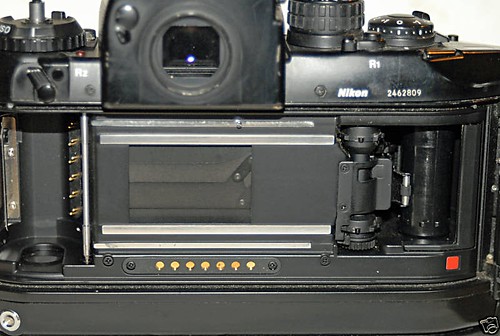
Rear view of the shutter (centre) on my Nikon F4 film SLR.
According to Nikon's promotional materials, the shutter on my F4 camera (the world's top-of-the-line professional 35 mm SLR when it was introduced in 1988) includes more than 200 components, which is more than some entire cameras of the same vintage. It remains one of the most sophisticated still-camera shutters ever made, with many miniscule levers and cams, a tungsten-alloy shutter balancer to minimize vibration, curtain components made of both metal and a carbon fibre–epoxy compound, and a maximum shutter speed of 1/8000th of a second.
Two curtains for extra speed
It's amazing that a physical shutter mechanism can open and close in 1/8000th of a second. So amazing, in fact, that it doesn't do that at all. Instead, pretty much every focal plane shutter you'll ever encounter has at least two curtains (which can comprise numerous parts each). One opens, the other closes. Here's how they're put together in my Nikon F4:
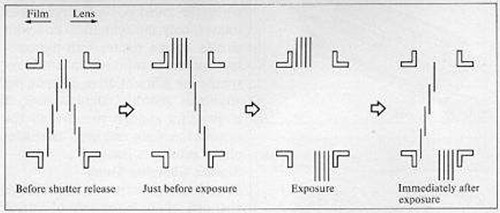
Nikon's diagram of how the F4 shutter works. Notice that there are two separate shutter curtains (one in front of the other), each made of four blades which are a fraction of a millimetre thick. The diagram doesn't show all the tiny levers, cams, springs, screws, fasteners, motors, and such needed to make this arrangement actually work. Diagram from the Nikon F4 Technical Guide, © 1988-1996 Nikon.
This shutter opens and closes from top to bottom, known as a vertical-travel design, which is also most common on modern digital SLRs and other cameras. When the camera isn't in use, both sets of shutter blades are down, keeping light from reaching the film. Here's what happens for relatively slow shutter speeds:
- When you press the shutter button, the camera's mirror flips up.
- Then the back four shutter blades slide up out of the way (very very fast), layering over each other like an elevator door opening on its side, but leaving the front shutter blades closed to keep light out. The film has not yet been exposed, but the shutter is now ready to do it.
- Next, for the actual exposure, those closed front four shutter blades slide down (very very fast) to let light from the lens reach the film.
- After the requisite interval (say 1/30th of a second), the waiting rear blades follow, sliding down again (very very fast) to cut off light to the film once more.
- When everything's done, the front blades slide back up and the mirror flips down into position.
That last move both returns the lens image to the viewfinder up above via the mirror, and makes sure no more light gets to the film, even if you bump the camera around, because both sets of curtains are closed. To see it all in the real world, you can watch a modern Nikon D3 SLR do its thing in this high-speed close-up frame-by-frame photo sequence of its focal plane shutter in action. There are also some great, informative animations of the process at Digital Photography School.
If you're looking through the viewfinder during this time, the view momentarily goes black (known as the blackout interval) while the mirror gets out of the way, so one disadvantage of SLR camera designs is that you can't actually see what you're photographing at the very instant you take the picture. But that instant is pretty short: usually something like a tenth of a second for all the flipping and sliding and springing to take place.
Many older cameras used horizontal-travel shutters, which are usually slower because the parts have to travel a bit farther. And lots of electromechanical and mechanical shutters use fewer parts, some of which may be heavier or which might move more slowly for other reasons, but they all work essentially the same way, with two curtains that follow each other to expose the film or sensor, and then cover it up again after a short time.
However, when the shutter speed gets really quick, things change a little. How fast "really quick" is depends on the shutter design and materials, but in general for SLRs, the more you spend on the camera, the quicker the shutter. Nevertheless, somewhere around a threshold of 1/60th or 1/90th or 1/125th or 1/200th or 1/250th or maybe 1/300th of a second, even the most modern vertical-travel focal plane shutters with the lightest, thinnest, best-engineered blades can't fully open and close any faster. (Start calculating the forces on those accelerating and decelerating sliding plates of metal and carbon fibre, or pieces of rubberized cloth in older cameras, as they whip open and closed really really fast, and you'll see why.)
So, decades ago, camera designers figured out a clever trick. It's not as if the entire film plane has to be exposed all at once. For a 1/1000th of a second exposure, for example, if the front curtain starts opening, and then, 1/1000th of a second later, the back curtain begins following, even before the front curtain has moved very far, then the two curtains can move across the film plane like two cars on a highway, with a gap between them.
How fast is fast?

For fast exposures, the rear shutter curtain follows the front one like a drafting car on the highway, creating a moving slit of light.
The gap is then a narrow slit of light moving across the film (top to bottom or one side to the other, depending on the shutter design), which means that while the slit of light can take a relatively long time to cross the gap, any particular slice of the film (or digital sensor) only gets exposed for a short fraction of that time. The slit can move at 1/60th of a second on some old mechanical cameras, or more like 1/200th or faster on modern DSLRs—but any particular slice of the film (or digital sensor) only gets exposed for 1/1000th of a second as the slit passes over it.
High-end professional shutters like the one on my F4, and even on new pro cameras like the Nikon D3 and Canon EOS 1D Mark III (Canon, please clean up your camera names!), can fully open and close as fast as 1/250th or 1/300th of a second, and their maximum shutter speeds go up to 1/8000th of a second, which means the slit passing over the focal plane is really, really thin. Those maximums have been about the same since at least 1988, so electromechanical focal plane shutters reached some sort of physical limit a couple of decades ago.
(Okay, that's not quite true. Minolta managed 1/12,000th of a second with an even-narrower slit in 1992. The Canon 1D could open and close in 1/500th of a second, and maxed out at 1/16,000th, but it had a hybrid shutter like those I talk about below. No current DSLR, especially the full-frame variety, comes close to that.)
You can imagine a few circumstances where this design could be a problem: freezing photos of really fast-moving objects (nearby aircraft, for instance) requires fast shutter speeds. Even 1/250th of a second might be slow enough to blur a passing jet. But a faster shutter speed doesn't really move the shutter mechanism faster, so the moving-slit design could theoretically smear out the final image if the object is moving fast enough and you're not moving the camera to follow.
So, again in theory, a fast passing airplane could be in different positions as the slit moves, smearing differently if the jet is moving with or against the direction the slit travels. However, in practice that almost never happens, even for supersonic jets, unless you are a specialized technical photographer. But in the early days of photography, it happened more frequently:
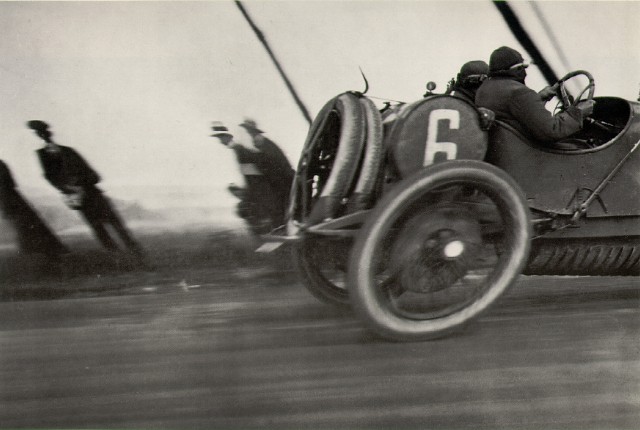
In the comments below, Andy Baird pointed me to this famous photo, which he noted "was taken by Jacques-Henri Lartigue in 1913. His large vertical shutter couldn't move very fast, so the wheels in the photo are ovals, because they were imaged as a series of horizontal slices." The racing fans are even more distorted because Lartigue was panning to follow the car. It's a great effect, even if it wasn't intentional.
The same effect is common when capturing motion using some electronic camcorder video shutters, or even with the live-view video mode on the new Nikon D90. It's noticeable enough there that reviewers have called the resulting video jello movies.
The main circumstance where the slit is a problem for most of us is when we use a flash. So camera manufacturers generally make it impossible to take flash photos with really fast shutter speeds. Mostly. Here's why.
How does a flash work?
If you took photographs with inexpensive cameras in the 1970s or earlier, you remember flashbulbs and flashcubes: expendable, single-use (or maybe four-use) flashes that attached to your camera, and which basically created a contained explosion (with audible paf!) to illuminate your pictures. They were slightly safer descendants of the flammable flash powder used by old-timey photographers.
Those flashes were good for lighting up a dark room, but didn't freeze action very well, because they took a fraction of a second to heat up (requiring the camera to wait a moment after you pressed the shutter release before it really opened the shutter) and lasted about 1/30th of a second before fizzling out. On the good side, when using a moving-slit shutter for faster exposures, a flashbulb was essentially "on" for the entire time the slit moved across the film—as far as the film was concerned, an old-style flashbulb was the same as any continuous light, like a studio lamp, a bright house fixture, or even the sun. You could use a flashbulb at any shutter speed, no matter how fast (though some of the light was wasted at faster exposures).
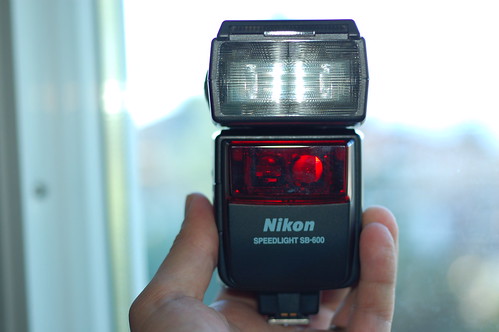
My Nikon SB-600 Speedlight flash, a modern descendant of the first strobe flashes of the 1960s.
But in the 1960s Nikon came out with what was generally a much better design: strobe flashes that they called (and still call) "Speedlights." Other manufacturers soon followed. By electronically creating a small, high-voltage electrical arc, like a lightning bolt, inside a sealed tube of inert xenon gas, strobe flashes generate a powerful and very brief pulse of light.
Speedlight flashes are great. They run on batteries, are quite power efficient, and last for thousands and thousands of pulses before they wear out. Nearly every modern camera (except mobile phones) either has an electronic strobe flash built in, or has a "hot shoe" you can attach one to.
These modern electronic flashes also freeze action very well, because their pulses last at most 1/1000th of a second. At lower powers, the burst can be 1/10,000th of a second or even substantially less (the only way for the strobe to emit less light is for the flash duration to be shorter). So, most of the time, as far as an electromechanical shutter is concerned, flashes are now instantaneous: rather than being "on" the whole time the shutter is open, they create an instant "pop" of light at some time during the exposure, usually timed to be just as the shutter opens.
And so we run into our moving-slit problem. If your flash is instantaneous, at fast shutter speeds where a slit is moving across the film or sensor plane, the flash "pop" will only send light through the slit, and only during part of the exposure:
- If the flash is being used to light up a dark image, the resulting photo will be totally black except for one flash-lit band across the image.
- If there is some ambient light and you're using the flash for "fill," there will be a bizarre stripe of bright flash-lit exposure across an underexposed background image in the rest of the frame.
Neither is what you want.
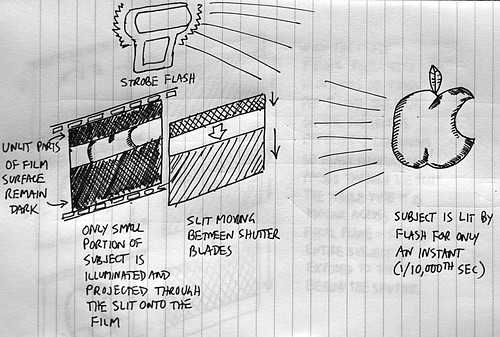
If the moving shutter curtains only expose a slit of light to the near-instantaneous flash pulse, only that slit gets recorded on the film or digital sensor. The rest of the frame stays black or underexposed. That's bad, so modern cameras make it almost impossible to do.
Flash sync, or X-sync
So, you only want to use a strobe flash like everyone has now when the shutter is completely open, and you can only do that if the exposure is at or slower than the threshold speed we talked about above, when the rear curtain doesn't start moving until the front curtain is already all the way across the focal plane. On an old camera that could be 1/60th of a second. On a top-of-the-line pro DSLR, it might be 1/300th of a second.
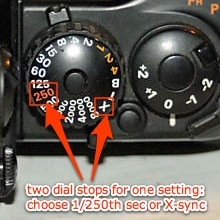 That value is so important that, ever since the Speedlight revolution of the '60s, camera makers have called it the flash sync speed of the camera: the fastest exposure you can set where the focal plane shutter is completely open for at least an instant, during which the flash can fire and expose the entire frame. On some cameras with a shutter-speed dial, that value is either highlighted in red or indicated with an X (or, on my F4, both!), so it's also called the X-sync speed, or just the sync speed.
That value is so important that, ever since the Speedlight revolution of the '60s, camera makers have called it the flash sync speed of the camera: the fastest exposure you can set where the focal plane shutter is completely open for at least an instant, during which the flash can fire and expose the entire frame. On some cameras with a shutter-speed dial, that value is either highlighted in red or indicated with an X (or, on my F4, both!), so it's also called the X-sync speed, or just the sync speed.
The slit exposure problem is sufficiently undesirable that "newer" cameras (i.e., most made in the last 25 or 30 years) generally won't even let you try to use a flash at shutter speeds faster than X-sync—they'll force the flash sync speed on you no matter what you do. If you turn on, flip up, or mount a flash on your camera, chances are it will set the shutter speed to the sync maximum (1/60th or 1/90th or 1/25th or 1/200th or 1/250th of a second, or whatever, depending on your camera). It will do that no matter what shutter speed you've told it otherwise, often even in fully manual mode.
Slower exposures are also fine with flash, and give you lots of creative options, from using fill flash to balance out harsh shadows, to creating nice motion blur while still freezing your main subject in sharp focus. Some let you control the flash's power, pre-pulse the flash to reduce "redeye" in your subjects (by making their pupils contract before the true exposure), or determine whether to fire the flash either when the shutter first opens or when it starts to close ("rear-curtain sync") for different effects. Therefore, cameras happily let you use flash at shutter speeds slower than X-sync, while blocking you from those that are faster.
Except when they don't. Which brings us to our last topic.
Wait a minute! My camera can use a flash at faster shutter speeds!
Here's a funny thing. My Nikon D50, an entry-level digital SLR introduced in 2005, has a 1/500th of a second flash sync speed. So did its predecessor the D70, and even the D1 from way back in the year 2000, as well as the newer D40. But other Nikon models (both old and new, many of them much higher-end cameras like the D3), have X-sync speeds of 1/180th, 1/200th, or at most 1/250th of a second.
Even the D40x and D60 offer only 1/200th flash sync, even though they are otherwise barely different from the D40, with its 1/500th sync! Other manufacturers show similar discrepancies. And even cheapie point-and-shoot digicams sometimes have flash sync faster than 1/250th of a second. Cameras costing $5000 and up, whose shutters have much higher total top speeds of 1/8000th of a second, have slower flash sync than cameras costing $600, or even $200! WTF? Is this a ripoff?
(Hint: no.)
Here's another funny thing. Some camera-flash combinations, usually on DSLRs using higher-priced external flashes from the same manufacturer, offer what they call "High Speed FP" (Focal Plane) mode, or something similar. With those setups, in most circumstances, flash photography is still limited by the usual X-Sync speed of 1/250th of a second or slower, but if you put the camera and flash into a special high-speed flash mode (controlled either from the flash, or from the camera, or both), you can use the flash at any shutter speed the camera supports, right up to 1/8000th of a second. But you have to specifically invoke that mode. If it offers unlimited flash sync, shouldn't it be on all the time?
(Hint: no.)
Let's tackle these two puzzles in order.
Flash sync with electronic and hybrid shutters
I mentioned back at the beginning that many point-and-shoot digicams, as well as all mobile phone cameras I know about, don't have shutters at all. Their instruction manuals might say they have shutters, but they don't: the digital image sensor is always exposed to light from the back of the lens—except when the lens cap is on or, as in many of those devices, if the lens aperture closes down when the camera is turned off.
Instead of an electromechanical shutter with light-blocking blades, these cameras have what is misleadingly called an electronic shutter. When you press the button to take a picture, the camera electronics briefly turn the sensor electronics on then off again. The sensor stays on for the exposure interval (1/30th of a second, or 1/1000th of a second, or whatever), so it's also a bit misleading to call it a "shutter speed" anymore, but we do out of tradition, and to be consistent.
This is a completely new way of doing things: film, of course, was always light sensitive and had to be kept out of the light right until it was processed. Electronic sensors can be told when to be light-sensitive, and can also turn on and off very quickly. And since there's no moving slit of light from shutter blades, if you're using a flash, it can fire and expose the whole sensor surface to light at once. So why don't all digital cameras use electronic shutters and get rid of those old mechanical ones once and for all?
There are always compromises with technology, especially in photography. Electronic shutters—or, more accurately, switchable digital light sensors—are complicated, because in addition to all the individual light sensor pixel photosites, microlenses, electron storage wells, and circuitry to move the data from them to the camera's electronics, they need additional electronics to control the switching.
The switching circuits take up space on the sensor surface, which means that:
- The manufacturer can't pack as many megapixels onto the sensor, or
- It won't be as sensitive to light because it captures fewer photons (meaning it doesn't perform as well photographing low-light scenes), or
- The images it produces have more noise in them.
Or all three. In addition, there are different types of sensors, such as CCD (Charge-Coupled Device) and CMOS (Complementary Metal Oxide Semiconductor), with different sub-types in each of them, some of which are more or less suitable to including electronic shutter technology, at least with current manufacturing processes.
There are also different types of electronic shutters, with some (called rolling shutters) that behave a bit like the film slit, or like the scanning electron gun of an old cathode ray tube (CRT) television, "painting" the image from top to bottom. That sets its own limit on how fast the shutter speed can be with a flash.
Finally, since the camera sensor remains exposed to light even when it's not turned on, unusual lighting situations, such as having the sun in the frame, can overload photosites and cause nasty "blooming" effects (scroll down here to see an example) that are at least as obnoxious as the slit-flash problem, as well as more subtle artifacts like banding or uneven noise.
As a clever compromise, on some lower-priced digital SLRs, camera makers have chosen hybrid shutters that use both focal plane curtains and switchable sensors. So for fast 1/500 flash sync, my Nikon D50 performs a neat trick:
- It opens its electromechanical shutter blades the usual way for an SLR, but relatively slowly (maybe 1/125th or 1/180th of a second, I'm not sure)—but the sensor is still turned off.
- While the shutter is open, the sensor turns on briefly for 1/500th of a second, like the electronic shutter on a point-and-shoot camera.
- While the sensor is on, the flash fires.
- The sensor turns off again.
- Lastly, the shutter closes again at its leisurely pace.
While that can cause a few image quality problems, such a design let Nikon install a less expensive, slower shutter while still offering faster 1/500 flash sync. However, it seems that such a design was only possible on the 6-megapixel CCD sensor used on the D70, D70s, D50, and D40. Once the company started using 10-megapixel sensors for the D40x and D60, those cameras had to revert to the normal electromechanical-only shutters with 1/200 sync.
So, in short, electronic shutters have various compromises. Currently, quality higher-resolution sensors that work well in low light also don't have the circuitry to act as electronic shutters, even in hybrid designs. So, for cameras where reliable performance, image quality, and low-light handling are most important, manufacturers continue to use old-fashioned electromechanical bladed shutter curtains, at least for now.
High-speed flash sync
With some higher-end external flashes, certain SLR cameras support what's known either as High Speed Sync (Canon, Sony, and others) or FP Sync (Nikon), which lets you take flash photos at any shutter speed the camera supports, right up to 1/8000th of a second. That's especially useful when using fill flash in daylight, particularly with high-powered telephoto lenses in wildlife or sports photography. How you set up High Speed Sync depends on your particular camera and flash: the controls might be on the flash unit, or in the camera menus, or both.
How is it that the High Speed Sync gets around the slit-flash problem and the traditional X-sync limit I've been talking about this whole time? It's not magic. Remember that the reason X-sync is an issue is that the flash burst is effectively instantaneous, and so only illuminates the focal plane through the moving shutter slit at one moment, rather than the entire time the shutter curtains are moving.
But newer strobe flashes can fire repeatedly, and do so in extremely rapid succession. In High Speed Sync mode, the flash fires its near-instantaneous bursts of light over and over, thousands of times per second, for the entire time the shutter slit crosses the focal plane. Effectively, in High Speed mode, the flash fires repeatedly like a machine gun, paf paf paf paf paf..., and acts like it's "on" for the entire X-sync time of 1/200th or 1/250th or 1/300th of a second, even though the exposure for any given slice of the sensor might be only 1/8000th of a second at top shutter speed.
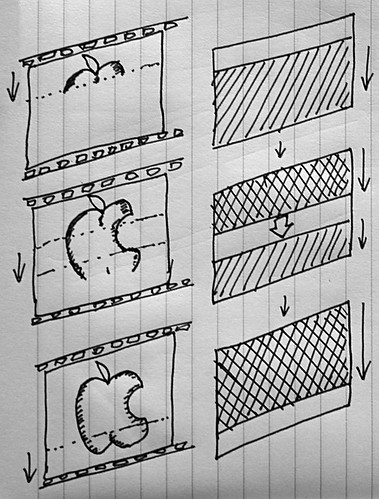
With the flash firing repeatedly thousands of times each second in High Speed mode, the light on the subject is effectively continuous, like a lamp or the sun. Flash illumination passes through the slit the whole time it is moving across the focal plane, so the entire subject is exposed to the film (or sensor) behind the shutter.
There are problems with that approach. It wastes a lot of light and power compared to the usual single flash burst, so the flash unit heats up, takes longer to recharge, and drains its batteries much faster. That's why it's not the default setting, and why only more powerful external flashes support it. A small pop-up flash on a DSLR that tried to fire repeatedly at full power might even melt, or at least suck the camera's battery dry pretty fast.
Old technology even in modern times
All current digital SLRs, as well as esoteric cameras like the Leica M8 digital rangefinder, use an electromechanical shutter of some sort, either as a hybrid design combined with an "electronic shutter" switching sensor, or with the traditional shutter alone. Most of the time, the old problem of the moving shutter slit still forces us to use a slower X-sync when taking flash pictures on DSLRs, even when cheaper point-and-shoot cameras can sync at higher speeds using electronic shutters. High Speed/FP Sync modes on DSLRs are one answer, but they are power hungry and only work with higher-end external flashes for some cameras.
I'm sure engineers at Canon, Nikon, Sony, Olympus, Pentax, and others are working on new ways to make flash sync speeds faster again. Electromechanical shutter designs started to hit their physical limits 20 years ago, but at the moment, having "slower" X-sync speeds of 1/200th or 1/250th or 1/300th of a second is a reasonable tradeoff with modern high-resolution, low-light digital sensors. Focal plane shutters have a century of design refinement behind them, and have proved reliable over decades of hard use, so they're not ready to be sidelined just yet.
Read more
Some useful resources:
- Wikipedia: The Science of Photography
- Thom Hogan: How digital cameras work
- Why digital cameras have mechanical shutters
- Nikon D3 focal plane shutter in super-slow motion
- Sync speed explained
- Photo.net forum: Mechanical vs. electronic shutter (image quality and sync speed)
- Photo.net forum: Mechanical vs. electronic shutters in DSLRs
- Wikipedia: Electronic flash
- Ken Rockwell: Sync speed
- High-speed sync for flash at any shutter speed
- Strobist: Control your world with ultra-high sync
- Photography 101.6: Shutter
« Previous: crop factors and "35 mm equivalent" lenses
Labels: barcamp, cameraworks, geekery, photography
16 August 2008
Camera Works: crop factors, 35 mm equivalents, and digital lenses
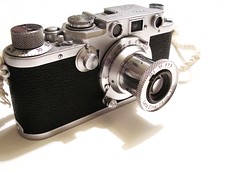 When you're shopping for digital cameras today, you'll see that they advertise lens focal lengths with numbers in "35 mm equivalent." Other specs might talk about a "crop factor" or "focal length multiplier" of 1.5 or 1.6 or 2.0 or more. What do those mean, and why didn't we hear about them back in the film days? Learning about 35 mm film will help us find out.
When you're shopping for digital cameras today, you'll see that they advertise lens focal lengths with numbers in "35 mm equivalent." Other specs might talk about a "crop factor" or "focal length multiplier" of 1.5 or 1.6 or 2.0 or more. What do those mean, and why didn't we hear about them back in the film days? Learning about 35 mm film will help us find out.
It's amazing how long 35 mm film (known as 135 film for still cameras) has been around. William Dickson, Thomas Edison, and George Eastman established its dimensions and specifications, right down to the distance between the sprocket holes, back in 1892—but that was for movie film. A number of still camera makers had the clever idea of using the same film stock for still pictures in the early 20th century, and it really took off among professional and enthusiast photographers in the 1920s, when Leica brought out its first tough little rangefinder cameras and excellent lenses.
NOTE: This article is now also available translated into Italian.
What is a full frame?
35 mm film gets its name honestly: the strips are 35 mm (about 1.4 inches) across, including the sprocket borders. In movie cameras it runs vertically, and the individual movie frames are 22 mm wide (leaving 13 mm for the margins and sprockets) by 16 mm high. But still cameras like the Leica M series (introduced in 1954) and Nikon F SLRs (first appearing in 1959) ran the film horizontally, as well as doubling the size of the image, making it 24 mm high by 36 mm wide. Today we call a film frame or digital sensor of that size "full frame."
Movie film was useful because it came in long rolls that could hold a lot of pictures, and it offered a good compromise between convenience, cost, and picture quality—especially compared to the sheet film and glass plates used by those big view cameras, where the photographer had to hide under a cloth and use bellows for focusing. The form of the standard 35 mm film roll cartridge was established pretty early too, which means that you can stick a brand-new roll of Fuji or Kodak film in a 50-year-old Leica. (And if you could find a well-preserved 50-year-old roll of film, it would fit in a new Canon film SLR too.)
The dominance of 135
Over the years many other film types came and went, from rolls for the popular Brownie in the '40s to small 120 cartridges for flashcube-equipped point-and-shoots from the '70s, disc film in the '80s, and Advanced Photo System (APS) rolls in the '90s. Polaroid did well with magical instant prints, and a big contingent of professionals has always used medium- and large-format film for extra high resolution in their Hasselblads and big studio cameras.
But nothing has lasted as long or been as ubiquitous and diverse as 135 film. You could get it as slide reversal film, colour or black-and-white print rolls, infrared strips, or super-sensitive cold-treated stock for telescope photography. Speeds ranged from super-slow but fine-grained Kodachrome to ultra-sensitive grainy print stocks for fast action and low light. You could buy 35 mm rolls anywhere from pharmacies in New York City to kiosks trailside in the Himalayas.
For 135 film, the 24 x 36 mm frame size never changed, so you could put pretty much any film roll in nearly any camera you could find, from a $200 autofocus pocketcam to a $2000 Nikon F4. And the lenses that camera makers created, whether the tiny plastic globule at the front of a single-use disposable cardboard camera or a $10,000 Canon L series super-telephoto, used focal lengths that made sense for that standard frame. "Normal" lenses had focal lengths in the 40 to 60 mm range. Wide-angle lenses had shorter focal lengths, and telephotos longer ones.
And then, around the turn of the 21st century, digital cameras started taking over. That threw everything into chaos.
Smaller sensors, smaller circles, smaller lenses
If you go back to my lens focal length article, you'll recall this diagram:
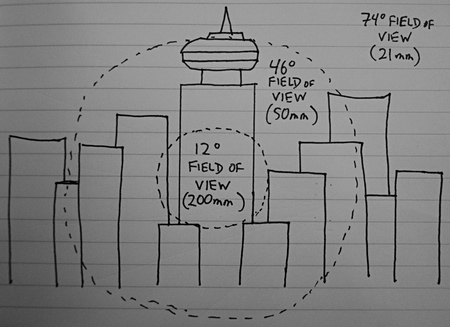
Fields of view for lenses of different focal lengths on a full-frame camera.
It shows the different fields of view from different lens focal lengths. When I first talked about that diagram, I discussed those angle-of-view circles as the cone of light that each lens "sucks in" from the front of the lens. But the whole point of the lens is that it not only sucks in that light, but projects it out the back too, onto the focal plane at the rear of your camera. That's where the projected image circle falls on the film or digital sensor when the shutter is open.
For most of the past century, lenses for SLRs and other 35 mm cameras were optimized to project a circle of roughly the same size, to cover the full 24 x 36 mm film frame behind the shutter:
That means that a full-frame image circle has to be at least 43.3 mm in diameter, because that's the diagonal width of the full film frame. Whether you're talking about a 500 mm telephoto, a 24 mm wide angle, or even an 8 mm fisheye or 70-200 mm zoom, whatever angle of view they're sucking in, they have to project a circle 43.3 mm across onto the film plane. (Actually, it's usually a bit wider, just to avoid the inevitable light falloff at the edges of lenses.)
Most digital cameras, however, are different. Until a few years ago, it was prohibitively expensive to produce a full-frame digital sensor, and it's still a lot costlier than making something smaller. As recently as 2003, the cheapest full-frame camera you could buy was a $5000 Kodak digital SLR, and that was a big price drop from its predecessors. Even today, there are only a few full-frame SLRs from Canon and Nikon (and soon, rumour has it, Sony), ranging from $2500 to $8000.
Most people who buy cameras are never going to spend that kind of money, so the solution was to make the sensors smaller (and thus cheaper to manufacture). Most digital SLRs have sensors with dimensions called "APS-C" or "DX" size, which is roughly 16 x 24 mm. Cameras using the Four Thirds system developed by Olympus and Panasonic have even smaller sensors, 13 x 17.3 mm. Most digital point-and-shoot cameras use smaller sensors still.
What does that mean for lenses? Two different things:
- Lens makers can manufacture lenses that project a smaller image circle for those smaller sensors, or
- Existing full-frame lens designs can work with smaller sensors, but those sensors only capture the middle portion of the image circle.
What's nice is:
- Someone like me, who already had a couple of lenses for his Nikon film camera, can buy a Nikon digital SLR (a D50, in my case) and mount those lenses right on it. They work great, even though the camera has a DX-sized sensor in it. The full-frame lenses project an image circle that's too big, but that's okay: the sensor just picks up the middle of that circle, and ignores the edges. Same for anyone with recent film lenses from Canon, Pentax, or other makers.
- Nikon, Canon, Pentax, Olympus, Sigma, Tamron, and other lens manufacturers can make lenses optimized for the DX-sized or Four Thirds sensors—lenses that project a smaller image circle. For a given focal length, those lenses can be smaller, lighter, and less expensive because they don't need as much precision-ground glass to project that smaller circle.
- It's also possible to make reasonably priced zoom and super-wide-angle lenses in focal-length ranges that would be extremely expensive for full-frame cameras. Again that's because of the smaller image circle they project. I have a lens for my D50's DX sensor that is an 18-135 mm zoom, and it cost a few hundred bucks. A lens like that for a full-frame camera would be huge and cost thousands, if it could be made at all.
- For point-and-shoot digicams with even smaller sensors, the lenses can be really tiny and inexpensive, because their image circles are even smaller in diameter. So you can get super-thin and small cameras to fit in your pocket and still take decent photos—much smaller and thinner than any 35 mm pocket cameras ever were.
There are problems too. Smaller sensors tend to create more image noise, especially as manufacturers pack more and more megapixels into them. Bigger sensors, while expensive, can not only handle more pixels cleanly, but can also be designed to work better in lower light. Yet even aside from those issues, different sensor sizes make things messy.
What does "35 mm equivalent" mean?
It turns out that the focal length for a "normal" lens (neither wide-angle nor telephoto), where the objects in the photograph appear in proper proportion as we see with our eyes, isn't universal. It depends on the size of the sensor or film frame. And, as luck would have it, a normal focal length is about the diagonal width of a film frame.
So for a frame of 135 film, or a full-frame sensor, a normal lens would have a focal length of 43.3 mm. (Most often, lens makers create 50 mm lenses instead, probably for technical reasons I don't understand, but that's close enough.) However, for a DX-sized sensor, a normal lens would instead be 28.4 mm. For a Four Thirds sensor, you're looking at 21.6 mm, almost exactly half the focal length of a normal lens for a full-frame SLR.
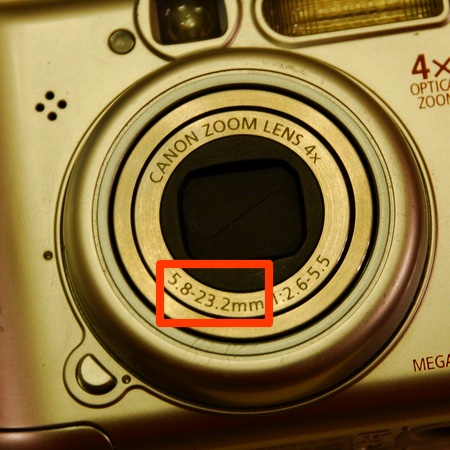 Point-and-shoot digicams with smaller sensors use even shorter focal lengths for a normal view. And for all those smaller sensors, wide-angle and telephoto mean different things too—my wife's Canon A540 has a 5.8-23.2 mm zoom lens, for instance. The whole range would be super-wide on a full-frame camera, but for a sensor only about 10 mm across, that lens covers medium-wide to medium-telephoto.
Point-and-shoot digicams with smaller sensors use even shorter focal lengths for a normal view. And for all those smaller sensors, wide-angle and telephoto mean different things too—my wife's Canon A540 has a 5.8-23.2 mm zoom lens, for instance. The whole range would be super-wide on a full-frame camera, but for a sensor only about 10 mm across, that lens covers medium-wide to medium-telephoto.
(Incidentally, it works the other direction as well. Medium-format cameras like Hasselblads use a much larger film frame or digital sensor, so a normal lens has a focal length of 80 mm or even 120 mm.)
All this makes shopping for a digital camera complicated. 50 mm is a normal lens on a full-frame SLR, but normal is 33 mm on a DX sensor, 25 mm on Four Thirds, and perhaps 8 mm on a point-and-shoot.
For point-and-shoot cameras it's actually worse than that. With different-sized tiny sensors, even different models from the same manufacturer might have different focal lengths for the same fields of view, and most camera buyers aren't in the mood for making frame-ratio calculations in the store.
So most smaller cameras list their lens zoom ranges as 35 mm equivalents. On my wife's Canon A540, for instance, the only place you'll see that 5.8-23.2 mm specification is on the lens itself. Marketing materials describe the lens as a "35-140 mm equivalent" in 35 mm-film full-frame focal lengths.
What does "crop factor" mean?
There's another way to look at that same relationship between full-frame and smaller sensors. Look again at the image circles for the various different sizes of sensors, and compare that to the field-of-view diagram I showed for wide angle, normal, and telephoto lenses:
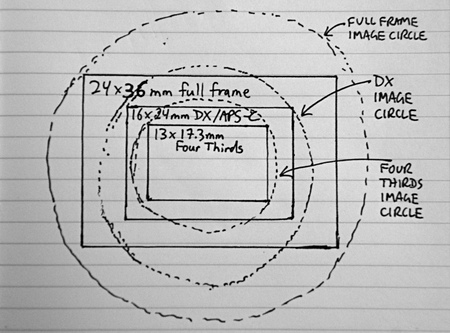

Left, sensor size image circles. Right, focal length fields of view.
Notice that, since the smaller sensors cut off the outer portion of the image circle, they essentially crop the picture to the centre portion only. And cropping narrows the angle of view of a picture, similar to using a lens with a longer focal length. But cropping does it at the focal plane at back of the camera instead of at the front of the lens. (You can even crop the image later, in a program like Photoshop, effectively turning a normal-lens picture into a telephoto shot—but at the cost of a fuzzier picture, because you delete pixels too.)
Since both a smaller sensor (cropping the image) and a longer focal length (closer perspective) narrow the angle of view of a scene, you can treat them as the same thing. A full-frame sensor (measuring 43.3 mm corner to corner) is about 1.5 times further across than a DX-sized sensor (measuring 28.4 mm corner to corner). That means the angle of view for a lens of any particular focal length is 1.5 times wider on a full-frame sensor than a DX sensor.
Remember that a 200 mm telephoto lens provides an angle of view 12° across on a full-frame sensor. But a DX sensor crops that down, dividing it by 1.5, so the angle of view is only 8°. That's the same angle of view as a 300 mm lens would have on a full frame, so you can say that the DX sensor makes a 200 mm lens behave like a 300 mm lens. Any lens used with a DX sensor will behave like a lens with 1.5 times the focal length. (Or, more accurately, the way a lens 1.5 times longer would behave on a full-frame sensor.)
That 1.5-times multiplier is called the crop factor or focal length multiplier of a sensor, which expresses two things:
- The diagonal width of a full-frame sensor compared to the cropped sensor.
- How much longer a lens would have to be to project the same angle of view onto a full-frame sensor.
Neatly, those are the same number, because the ratios are the same. Both of them are like zooming in 1.5 times on a full-frame image, so you can only see the middle part.
The Four Thirds sensor is even smaller, about 21.6 mm across. Since that's about half the diagonal width of a full frame, lenses connected to a Four Thirds camera have a crop factor of 2.0, so a 200 mm lens behaves like a 400 mm lens. And a 25 mm lens behaves like a 50 mm lens.
Once you get to point-and-shoot digicams, the crop factors get silly. My wife's Canon has a crop factor of about 6.0, for instance (which is how a 5.8-23.2 mm lens becomes "35-140 mm equivalent"). So the math is the same. Which numbers you see depends on marketing considerations:
- Because point-and-shoot cameras come with a single zoom lens, and because their crop factors are pretty extreme, they're usually advertised in full-frame equivalent terms ("35-140 mm equivalent"). That makes it simple to compare cameras.
- Since digital SLRs have interchangeable lenses, they're usually advertised using the crop factor ("1.6 focal length multiplier") instead—you might be putting all sorts of lenses on them, and it's less confusing if those lenses advertise their actual focal lengths. That makes it simple to compare lenses.
Interestingly, if camera manufacturers used the same terms in describing sensor sizes as they do with resolution (megapixels), they'd have to say that a DX sensor is only 43% the resolution of a full-frame sensor, and a Four Thirds sensor is only 25%! That's another reason why crop factor is the term they prefer.
Tradeoffs
The math makes it seem like you can just shrink your sensor and get more telephoto power for free. That's not quite true:
- Smaller sensors are noisier, as I've already mentioned.
- It's harder to get lots of pixels on them without microscopic electrical interference degrading the image, so it's also harder to make small sensors perform well in low light.
- There are changes in the depth of field: for a given field of view and lens aperture, smaller sensors put more of the image in focus. That's fine if you want deep focus, but if you prefer those nice out-of-focus backgrounds I described in my aperture and f-stops article, it will be harder to accomplish with a smaller sensor.
There are also problems at the wide-angle end. I have a 24 mm lens that gives a very wide field of view on my film camera, but on my DX-format digital SLR (1.5 crop factor), it acts like a 36 mm lens, which isn't all that wide at all. For a similar view, I would need a 16 mm lens, or maybe 18 mm if I don't mind a little closer view.
Building a lens that wide which works on both DX and full-frame sensors is difficult and costly—Nikon and Canon make them, but they cost at least $1500. Now, you can get 16 mm or 18 mm lenses (or zooms that go that wide) for digital SLRs, for much less money. But they are "digital only"—being built smaller and less expensively, they project a smaller image circle, which means that if I put my 18-135 mm DX zoom lens on my old Nikon F4 film camera, there's a big black vignette circle around the image when I look through the viewfinder and take photos:
So a serious wide-angle lens for a DX camera could be pretty much useless on a full-frame camera, unless you spend a lot of money. And the problem only gets worse with smaller sensors like Four Thirds.
It's all relative to full-frame
The full-frame 35 mm film size, which camera and lens designers have been working with for a century or so (it became an accepted standard for movies in 1909), remains an excellent compromise between image quality and portability. Some people still prefer medium-format cameras, and will pay tens of thousands of dollars for a digital Hasselblad, and thousands more for lenses, all of which are beastly to lug around. Most of us are content with smaller-sensor SLRs and point-and-shoot pocket cams.
But most professionals and many enthusiastic amateurs are returning to that full-frame sensor size, and in the past few years cameras with sensors that size have become at least somewhat affordable (if you consider $2500 cheap). That will likely continue, and full-frame cameras will get less expensive.
So in a few years, we could be back to the same old 35 mm standard popularized by Leica more than 80 years ago. Even if not, it looks like we'll be speaking in terms relative to that old 135 full frame for a long time to come.
Read more
Some useful resources:
- Wikipedia: The Science of Photography
- Wikipedia: 135 film
- Wikipedia: Crop factor
- Ken Rockwell: Crop Factor
- DSLR Magnification
- Crop Factor Explained
- The Field of View Thing
« Previous: apertures and f-stops
Next: shutters, flashes, and sync speed »
Labels: barcamp, cameraworks, geekery, photography
07 August 2008
Camera Works: what are f-stops and why do they matter to the pictures you take?
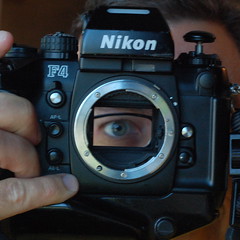 The pupil of your eye is an amazing adaptation. In bright light, your brain tells tiny muscles at the front of your eyeball to close your pupils down to miniscule circles, and when that happens you're not blinded. If you're like me and need strong glasses, take your glasses off and you'll also notice that in bright light things are a little less blurry than otherwise.
The pupil of your eye is an amazing adaptation. In bright light, your brain tells tiny muscles at the front of your eyeball to close your pupils down to miniscule circles, and when that happens you're not blinded. If you're like me and need strong glasses, take your glasses off and you'll also notice that in bright light things are a little less blurry than otherwise.
In dim light, your brain tells the muscles to open your pupils up wide, and you can see better in the dark (although it takes the rest of your optical system a few minutes to adjust its sensitivity to compensate, and human night vision is pretty lousy compared to that of many other animals). When you get your eyes checked, the ophthalmologist's annoying eyedrops trick your eye muscles into opening the pupils all the way, so that the coloured part of your irises almost vanish around the edges. You might notice then that even with glasses on, you can't focus properly, or read a book or computer screen.
Building lenses to work like the human eye
Camera lens designers take many cues from eyes, and one of the main ones is having an iris (the lens diaphragm) inside the lens that can open or close to let more or less light through. Instead of using muscles and tissues, camera lens diaphragms have a set of thin, overlapping pieces of metal known as aperture blades, and instead of the pupil, the opening in the middle is the aperture:
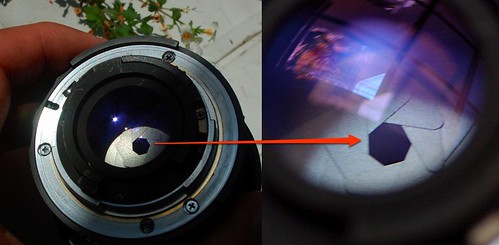
There are seven metal diaphragm blades in this lens, which open and close the central aperture. Other lenses may have more or (rarely) fewer blades, and in some designs the edges of the blades might be curved so the aperture is more like a circle than a straight-edged polygon.
As in the human eye, the aperture lets the photographer (or the camera's exposure computer) increase or reduce the amount of the light that gets through to the film or sensor at the back of the camera body. But why would you want to do that? Why not let in as much light as possible all the time?
Depth of field, speed, and sensitivity
There are three main reasons to vary the lens aperture:
- To control the depth of field (also known as the depth of focus) of the image.
- To permit shooting at either a faster or slower shutter speed.
- To use greater or lesser sensitivity (often called "ISO") for your film or digital sensor.
Depth of field refers to how much of a photograph is in focus, like this:
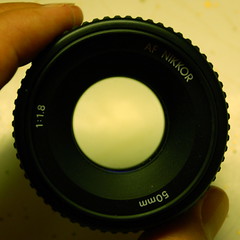
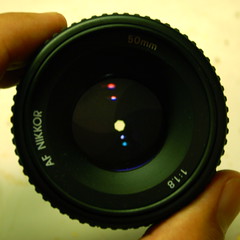


On the bottom left, an image with little (shallow) depth of field, using a wide aperture (see the lens on top left). All you can see clearly is the laptop screen. On the bottom right, the same shot with greater (deep) depth of field, using a small aperture (see the lens on top right). You can now see my foot, the bed, and the dressers in the background.
In both photographs, the laptop closest to the camera is in focus. With little depth of field (on the left), everything in the background is blurry. With more depth of field (on the right), not only can you see the laptop in focus, you can also see my sock, a book on the bed, and the bedroom dressers in the background, also largely in focus. If you closely, you can even see that the reflections in the screen of the laptop are blurry on the left, but sharper on the right.
The physics of light rays, and the way they refract and diffract inside lenses and apertures, means that when the aperture is really small, the resulting image has greater depth of field—just like your eyes on a sunny day. (A pinhole camera, which has an extremely tiny aperture, offers such great depth of field that it doesn't need a lens at all.)
And when the aperture is really large, the depth of field is shallower, just like when you get eyedrops at the ophthalmologist's office—and can't even read a newspaper because it's so blurry. So depending on how much of your image you want in focus, you're going to set the aperture differently. For a portrait with a nice soft background, you'll choose a large aperture. For an image where both nearby and distant objects need to be in focus, you'll choose a small aperture:


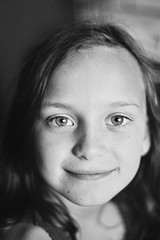
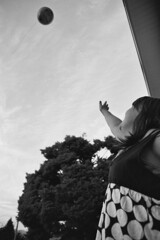
Left, large aperture, shallow focus (even my younger daughter's hair is a little out of focus, but her eyes are sharp). Right, small aperture, deep focus (my older daughter's dress is in focus, but so is everything else, including the distant clouds).
Of course there's a tradeoff. The smaller the aperture of the lens, the less light gets through, and so either:
- You'll have to expose the film or sensor longer to get the same amount of light on it, or...
- You'll have to increase the sensor sensitivity (or use faster film) to collect the light more efficiently.
But that can work to your advantage too, even ignoring depth of field:
- If you're photographing fast-moving things (sports, cars, kids, aircraft, birds in flight) or otherwise want to freeze the action, use a large aperture so you can use a fast shutter speed, since you're letting in more light.
- If you want to minimize film grain or sensor noise, use a large aperture with lower sensor sensitivity or slower, more fine-grained film.
- If you want a long exposure (to make the water in a waterfall look soft, or to blur motion so it looks like motion, or to get streaks of light from cars driving at night), use a small aperture to let in less light so you can use a slower shutter speed.
- If it's really, really bright out (a sunny day on a snowy ski hill or sandy beach), use a small aperture to avoid overloading the sensor or film.
Small and large apertures now make sense, because they give you a lot of creative control over your images, and let you adjust your picture-taking to your subject, the light, and your photographic conditions. But why are the numbers that photographers use for them, like f/1.8 and f/5.6 and f/22, so strange? What do those numbers mean, and why do the larger numbers represent smaller apertures?
What is an f-stop?
The specific setting of a lens aperture at any time is called its f-stop. (We'll see why below.) On almost all modern cameras, including big single-lens reflex (SLR) models, you adjust the f-stop with buttons or control dials, but for most of the 20th century, photographers did so by adjusting the aperture ring on the body of the lens. Many lenses still include an aperture ring for compatibility with older cameras:

The aperture ring on my 50 mm lens here is set to f/8 (the "8" below the white dot), about midway through its range.
The f-stops available range from small numbers (like 1.8 or 2.8 or 3.5) to large (like 16 or 22 or 32). Counterintuitively, the small numbers represent large apertures (on this lens, f/1.8 is wide open and lets in the most light, for instance), while the large numbers are small apertures (f/22 is the smallest aperture, letting in the least light).
To show why, we'll do some really simple math. First, here's a diagram of where the aperture might be in a typical camera lens with multiple glass elements in it:
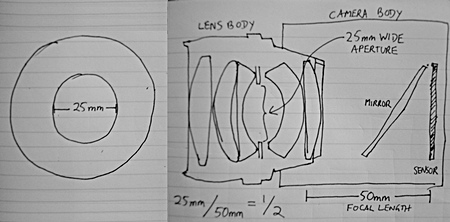
A lens looked at two ways: On the left, looking straight into the front, with the aperture open to a width of 25 mm. On the right, a cross-section of the side (with its multiple glass lens elements), with the lens attached to the camera, again with the aperture open to 25 mm, and showing this lens's focal length of 50 mm.
The f-stop setting of a lens is the ratio between the diameter of the aperture and the focal length of the lens:
focal length of lens
Another way to write that is aperture diameter : focal length. In this example, we have 25 mm aperture : 50 mm focal length, which is 1 : 2. Another way to say it is that the aperture is (in this case) half the focal length, or f/2. A photographer would pronounce that "eff-two." Since the widest aperture of a lens is important to know, lenses are usually specified that way, so you could buy a lens labelled as a 50 mm f/2 or 50 mm 1:2 lens.
Yet another way to think of it is that it would take two apertures of that width to equal the focal length of the lens.
Let's look at a bunch of other f-stops for my lens:

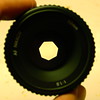
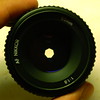
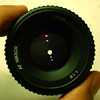
My 50 mm lens set to apertures of (from left to right) f/1.8, f/4, f/8, and f/16.
At f/1.8, the aperture is about 27.8 mm across, and it would take 1.8 of them to equal the focal length of the lens. At f/4, you'd need four of the 121/2 mm apertures to equal the focal length. At f/8, you'd need eight 61/4 mm apertures to equal the focal length. At f/16, you'd need 16, since the aperture is only 31/8 mm across.
But why isn't the lens aperture ring simply marked with those diameters? Why doesn't it read 27.78, 17.86, 12.5, 8.93, 6.25, 4.55, 3.125, 2.27 instead of 1.8, 2.8, 4, 8, 11, 16, 22? There's a good reason, and it's the clever part.
F-numbers work for any lens, however you measure it
The cool thing is when you start to use different lenses, or different cameras. For a given amount of light entering a lens, a particular f-stop always lets the same amount of light through to the sensor or film—and it doesn't matter what focal length the lens is or what kind of camera you're using!
Here's why that's important. We already know that when a 50 mm lens is set at f/2, the aperture is open 25 mm (see my diagram above). But what about a 200 mm telephoto lens (four times the focal length)? To be open to f/2, that lens's aperture would have to be open half that lens's focal length, an opening 100 mm in diameter (four times as wide). And a 24 mm wide-angle lens? At f/2, its aperture is open only 12 mm, or half its focal length.
So if the apertures of every lens were labeled with their actual widths, every lens would be different. The aperture ring on a 200 mm lens might read:
100.00, 71.42, 50.00, 35.71, 25.00, 18.18...
But a 24 mm lens would be:
12.00, 8.57, 6.00, 4.29, 3.00, 2.18...
Even worse, to take a photo of the same scene under the same lighting conditions, you'd set the 200 mm lens to aperture 35.71, but set the 24 mm lens to aperture 4.29—both to get exactly the same amount of light to your film or sensor. If you think f-stops are confusing now, imagine how confusing that would get.
Instead, I know that a 200 mm lens set to f/5.6 lets through the same amount of light as a 24 mm lens set to f/5.6, and the same as a 50 mm lens set to f/5.6. I even know that if I could get myself an 8 mm fisheye lens, or a 600 mm super-telephoto, those lenses would also let through the same amount of light at f/5.6. For a given brightness of a scene, any lens set to the same f-stop can use the same shutter speed and sensitivity to get a proper exposure.
That's why f-stops are a good way to measure aperture, and why we put up with having big numbers mean small openings. But there's one last thing.
Why those particular aperture and shutter stops?
Okay, so if we're going to use f-numbers, why aren't they a more sensible sequence, like 1, 2, 3, 4, 5... or at least 2, 4, 8, 16, 32...? Why those weird ones in the middle, like 2.8 and 5.6 and 11?
That's because each stop on the aperture ring doubles the amount of light hitting the focal plane, if you're opening it wider, or cuts it in half, if you're closing it down. (Most of the time, anyway—sometimes the widest aperture doesn't exactly double the light from the next-widest, just because the lens isn't designed to open any wider. So my lens opens to f/1.8 instead of f/1.4.)
Imagine your lens is set to f/5.6 and the light meter says a proper exposure is 1/250th of a second. You can open the lens up one stop, to f/4, and twice as much light gets through. So you can make the shutter speed twice as fast, 1/500th of a second, and still get the right exposure.
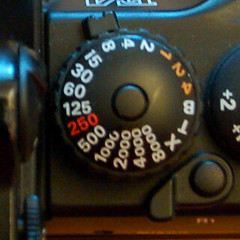 This explains why the shutter settings are the way they are too, as shown on the shutter speed dials of older cameras. Click your lens aperture ring one stop wider (f/5.6 to f/4), and you can click the shutter speed ring one stop too, to the next faster speed (from 1/250th of a second to 1/500th).
This explains why the shutter settings are the way they are too, as shown on the shutter speed dials of older cameras. Click your lens aperture ring one stop wider (f/5.6 to f/4), and you can click the shutter speed ring one stop too, to the next faster speed (from 1/250th of a second to 1/500th).
Click the shutter speed four stops slower (say, from 1/1000th of a second to 1/60th of a second), and you need to close the aperture of the lens four stops narrower (from f/4 to f/16) to get the same exposure.
There's a little bit of convention and standardization in all those numbers. Each f-stop, letting in twice the light, represents an increase in diameter of a factor of the square root of 2 (written as ![]() ), which is about 1.4142. Multiply 1.4142 by itself and you get 2. Multiply that by 1.4142 again and you get 2.8284. Multiply that by 1.4142 and you get 4. Multiply that by 1.4142 and you get 5.6568. Round that series out and you get:
), which is about 1.4142. Multiply 1.4142 by itself and you get 2. Multiply that by 1.4142 again and you get 2.8284. Multiply that by 1.4142 and you get 4. Multiply that by 1.4142 and you get 5.6568. Round that series out and you get:
1.4, 2, 2.8, 4, 5.6, 8, 11, 16, 22...
Look familiar? It's all in the physics of light passing through roughly circular holes. Increase the diameter of a hole by 1.4 times or so, and you double the light getting through. Why is that? That takes a bit more math. Remember the formula for the area of a circle from math class? To remind you, it's πr2, where r is the radius of the circle, i.e. half the diameter.
If you want to double the area of a circle (and thus double how much light it lets through), you need to multiply the value of r2 by 2. To do that, you multiply r by the square root of 2 (![]() ), or about 1.4. And when the radius increases by 1.4 times, so does the diameter, which is the width of the little pupil that lets light through the aperture blades of the lens. And that's why each f-stop on your lens is 1.4 times the value of the previous one. One stop larger, double the light. One stop smaller, half the light.
), or about 1.4. And when the radius increases by 1.4 times, so does the diameter, which is the width of the little pupil that lets light through the aperture blades of the lens. And that's why each f-stop on your lens is 1.4 times the value of the previous one. One stop larger, double the light. One stop smaller, half the light.
The same for shutter speed numbers, but there it's even simpler, because you don't need any area-of-a-circle calculations. Each faster shutter stop lets in half the light, because the shutter is open half as long. Take a one second exposure. To get half the light, make it 1/2 second. Half that is 1/4, then 1/8th of a second, then 1/16 (conventionally abbreviated to 1/15), then 1/32 (or 1/30, which is close enough for photographic tolerances), 1/64 (or 1/60), 1/128 (close to 1/125th), and so on. So your shutter speed dial reads:
1, 2, 4, 8, 15, 30, 60, 125, 250, 500, 1000...
My guess is, if history were skewed and photography had been invented after digital computers, things would be different. We've all gotten used to powers of two (like 32, 64, 128, 256, 512, 1024, 2048, etc.), so we'd have those kinds of numbers on the shutter speed dial and on our digital camera LCD screens instead of the rounder numbers we see now.
Read more
Some useful resources:
- Wikipedia: The Science of Photography
- Wikipedia: F-number
- Understanding Camera Lenses
- Controlling Light
Next: crop factor & digital lenses »
Labels: barcamp, cameraworks, geekery, photography
